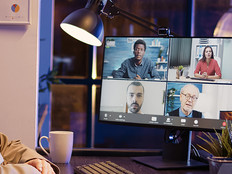Cbeyond Innovates with Video Conferencing
Effective communication and fast decision-making are essential ingredients for business productivity and success. Given the unpredictable state of the economy, it’s essential for management to disseminate timely and pertinent information to employees effectively, with minimal impact on the bottom line.
Perhaps nobody understands that better than a communications company like Cbeyond. Based in Atlanta, Cbeyond provides IT and communications services — voice, broadband, mobile, data backup and security — to more than 55,000 small businesses.
From its modest beginnings, Cbeyond has expanded its services to 14 major metropolitan U.S. markets. To better meet the communication needs of its highly mobile employees, Cbeyond management recently upgraded its video conferencing capabilities. Today, the company uses video conferencing technology to effectively reduce travel costs, speed decision-making, make better use of executive time and expedite the hiring process.
Widespread Usage
In a fast-paced business environment, video conferencing applications can reach far and wide. At Cbeyond, these include prospect interviewing, employee performance management, staff training, sales meetings, new product development, technical support and more.
“When the business was smaller, we had a pretty standard video conferencing setup,” says Jeff Caplan, Cbeyond’s senior director of IT operations. “As we entered more markets and opened more offices, we looked to video conferencing to speed communication and save costs.”
For example, Cbeyond is now using video conferencing to effectively interview candidates for sales positions. “Expanded video conferencing capabilities allow management in our central HR office to interview applicants face to face in regional facilities, with no travel,” Caplan explains.
Susan Mitnick, senior director of training at Cbeyond, says high-definition video conferencing has dramatically aided training. “We utilize the technology to establish virtual classrooms for our management-training program,” she says. This enables participants in a variety of cities to assemble for training sessions to learn new concepts and share ideas.
The dynamic allows the firm to pull together managers into groups instead of strictly training onsite at the individual level. “We also utilize video conferencing as a means to conduct ‘train-the-trainer’ sessions,” she adds. “It allows us to observe and coach new trainers in both practice and actual classroom environments, without the cost of traveling from city to city.”
In addition, Cbeyond’s sales management teams have been able to curtail their travel by using video conferencing, which saves money. “The teams are also more efficient, as they spend less time in airports,” Caplan adds.
Core Technology Components
Upgrading Cbeyond’s video conferencing capabilities meant almost starting from scratch. “Initially, we had fewer than 10 aging legacy video endpoints or terminals,” Caplan notes. “Only a few of those had limited multiparty licensing for up to three video units. Consequently, we could never add a fourth caller to the conference.”
Growth caused the company to look for a more up-to-date solution. “We have a regional sales management structure,” Caplan says. “And many of those regional sales markets have multiple satellite offices.”
Cbeyond deployed the Polycom RMX 2000 real-time media conference platform, which allows for full multiparty video conferencing. With a new platform in place, the company purchased 10 high-definition Polycom HDX 8000 Series video conferencing endpoints.
Video conference endpoints or terminals are typically equipped with video cameras and video displays along with audio speakers and a microphone array. “The high-definition video completely revolutionizes the video conferencing user experience,” Caplan notes. “It allows the participants to feel as if they were truly present at the remote location.”
Central management of the firm’s video conferencing solution is accomplished through Polycom’s Converged Management Application (CMA) 4000. The video management product can centrally manage visual communication across an entire organization, from large conference rooms to individual desktops.
Among other benefits, the CMA 4000 allows fast, centralized deployment and provisioning of video conferencing endpoints, easy integration with corporate directory services and sophisticated centralized reporting. Each Cbeyond conference room has an LG 42-inch display, which makes for an immersive conferencing experience.
Engagement Is Key
Why is Cbeyond sold on enhanced video conferencing? “It adds a layer of personal attention that keeps people more engaged and ramps up the caliber of the meeting,” says Caplan. “It’s almost like being there.”
Since implementing the technology, video conferencing calls at Cbeyond have skyrocketed to nearly 900 calls per month. In addition, total video conferencing time rose from fewer than 100 hours per month before the upgrade to 313 hours in the month after installation and more than 400 hours a month thereafter.
There’s also an advantage to being able to see the silent body language of all the participants. “There was a UCLA study that suggested that up to 93 percent of communication is nonverbal,” Caplan says. “That’s a very different level of productivity.”
One of the best aspects of the Polycom solution, according to Caplan, is ease of use. “We like the fact that our new users can walk into the conference room, pick up the remote and implement a video conference successfully without a user guide or IT person.”







